| The Union Leader New Hampshire, USA |
Bridgewater, Hebron build $2m incinerator By CAROL CARTER Sunday News Correspondent |
BRIDGEWATER — With an eye toward the future, residents of Bridgewater and neighboring Hebron have invested $2 million in a state-of-the-art incinerator that promises a long-term solution to their solid waste disposal. Although the start-up cost was high, selectmen believe the combined recycling and incineration process will save thousands of dollars down the road.
Tipping fees — the charge towns pay commercial landfills to take their trash — currently range from $35 to $80 per ton, according to Hebron Selectman John Matthews.
The towns generate about 450 tons of trash a year, which, along with waste wood, would cost about $100,000 to haul away. However, that cost could triple in the coming decade.
That fee will likely soar in the next decade as landfills reach capacity and trash is hauled to other states, selectmen warn.
“Towns just want to transfer their trash, but when those places are filled, the trash has got to go someplace else. We expect market rates could double in the next 10 years so we hope this will be cheaper than the alternative,” said Bridgewater Selectman Terry Murphy.
Pam Monroe, administrator of the Air Resources Division Compliance Bureau at the New Hampshire Department of Environmental Services, said the facility exceeds anything else in the Granite State. “They are state-of-the art compared to other towns. They went above and beyond any regulatory requirements for emissions monitoring,” said Monroe.
Currently, there are commercial incinerators in operation at Claremont and Penacook with small municipal incinerators in Candia, Litchfield, Ossipee and Wilton, Monroe said.
The Bridgewater-Hebron Refuse District formed in 1975 was initially “a typical old dump,” according to Matthews. A small incinerator went online two years later but failed DES compliance tests a few years ago. Looking ahead, voters in these Newfound Lake area towns with a combined population of 1,300 residents floated a 10-year bond and gave selectmen a green light to design a new facility.
And these selectmen brought a wealth of expertise to the drawing board for free. Matthews, a retired brigadier general with the New Hampshire National Guard was joined by Murphy, a professor at Plymouth State University and Bridgewater Selectman Hank Woolner, an MIT graduate who owns a machine shop.First the trio devised a way to keep on burning while building the new facility.
“We left the old incinerator in the corner and built a temporary wall while we expanded the building. Then we decommissioned the old incinerator,” said Woolner.
But the new equipment and hazardous materials that sometimes finds its way to these facilities posed a unique problem.
“There’s a lot more to the solid waste business than people would imagine. We had to be trained so we could train other guys to run this,” said Murphy.
So the trio went back to school for what they joke is a Dumpology Degree. Now they each hold a Level Four Operator-Manager License from the DES.
They not only keep a sharp eye on the daily operation but armed with tools from Woolner’s machine shop, they make occasional adjustments. Recently, Murphy even climbed the stainless steel emissions stack to replace what Woolner calls “the device that sniffs the air.”
Throughout the project, they worked closely with construction crews and Advanced Combustion Systems of Bellingham, Wash., fitting the twin 8,000-pound burn chambers into the expanded building and installing all the environmentally sensitive equipment.
Selectmen frequently sent sketches to Washington and the firm returned computer drawings, Matthews recalls. The project, birthed in 2000, was delivered last summer.
“There was a sigh of relief when it started up,” Woolner said.
Residents in these Newfound Lake area towns have cooperated throughout the process, selectmen added.
For these 1,300 year-round residents, recycling is a habit. Metal here, trash there and plastic in another bin. Old shingles are pulverized by a Maine firm and used to surface roads. Plastics are stored inside awaiting transport to a recycler. Metals and old appliances are also recycled and waste wood is ground, mixed with trash and burned.
Prior to coming online last October, the town was spending about $60,000 annually disposing of this waste wood, according to Murphy. The new grinder will actually pay for itself in one year, he added.
Likewise, the packer to compress paper is expected to be a wash in about 18 months. “This is a business really. We want to minimize the cost and maximize the revenue,” said Murphy.
The Refuse District has a $400,000 annual budget with half that amount earmarked for the bond.
The incinerator is nowhere near capacity, operating only two and a half days a week, a little longer in the summer.
The town doesn’t plan to take in waste from other towns for money.
At the facility, Manager Gerry MacDonald and his two part-time employees weigh each bucket loader of trash before dropping it into the hopper. Two and one half tons of garbage goes in one door and 400 to 500 pounds of ash comes out the other door, MacDonald explained.
The ash is shipped to a commercial operation in Bethlehem.A computer calculates burn time and the amount of propane required for each filling. Chambers have separate burners, operating at six and one-half million BTUs.
Throughout the process, scrubbers treat gases to remove pollutants before emissions hit the stack. Although DES testing continues, emissions have been well below standards because the town doesn’t burn plastics, selectmen said.
All emissions are monitored and recorded around the clock by a sealed computer.
Wastewater from the scrubbers is pumped into an evaporator manufactured by PSI Water Systems of Hooksett. That water is boiled off and sludge moves into a steel tank. Since October, only one-half inch of sludge was produced.
Selectmen are confident the towns made the right choice. In a tourist region that triples its population each summer, this system will serve the towns for many years, they said. Devices can even be added to upgrade the system to meet future regulations.
“We built for the future,” Murphy concluded.
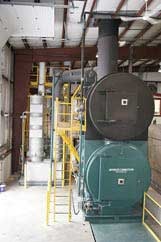
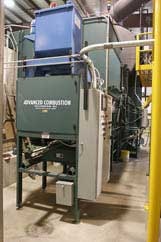
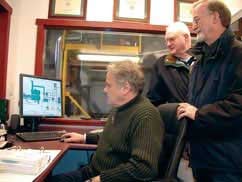
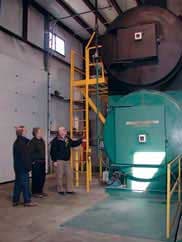
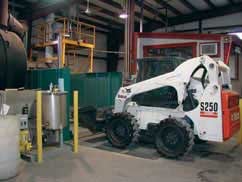
Leave a Reply
You must be logged in to post a comment.